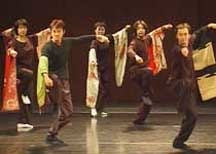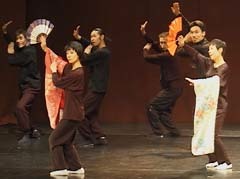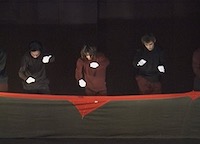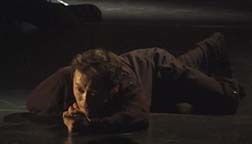 Avant-Garde Kabuki "Walk"
Avant-Garde Kabuki "Walk" written and directed by Masakatsu Gunji.
A stage legacy to remember.
| 【Contents】 | |
|---|---|
| 1 | Page Top |
| 2 | Trailer |
| 3 | Overview |
| 4 | Masakatsu Gunji |
| 5 | Cast & Staff |
| 6 | Script "Walk" |
| 7 | Watch on demand |
Trailer
Overview

What is the meaning of "Walk" in this life?
Masakatsu Gunji, Kabuki researcher and director (Professor Emeritus, Waseda University).
The theme Gunji chose for his work was "walk”, as he was stricken with a disease and foresaw his own death.
In 1997, Gunji wrote and directed the avant-garde kabuki play "Walk" with young and veteran stage actors instead of kabuki actors, and passed away the following year due to cancer.
"Human tragedy is also a comedy of life from a different point of view.
Crying and laughing. Drama becomes art as a representation of life."
Guji states so.
“Walk” is a reflection of his own life and an expression of human life through kabuki and dance.
It is a stage like a testament (message) with a warm perspective on human activities and a strong criticism of human stupidity.
A stage legacy remembering.
A characteristic of Gunji's numerous articles and writings is said to be his incorporation of a folklore perspective into his study of kabuki, highlighting the spiritual structure of the performing arts and the Japanese people.
In the play "Walking", Gunji skillfully incorporates not only Kabuki plays but also folk dances such as the Bon Dance of Shiraishi Island and the Mugiya-bushi, Bunraku, and Noh, and tries to get deep into the spiritual structure of the Japanese people.
Finally, he connects them not only to Japan but also to the spirit of Asia.
This video work is a complete recording of the Tokyo premiere (1997) of such a stage performance "Walk".

Masakatsu Gunji
Masakatsu Gunji (1913-1998)
Kabuki researcher, director, theater critic, professor emeritus at Waseda University. Born in Sapporo.
1939 Graduated from Waseda University, Department of Japanese Literature. He is a disciple of Shigetoshi Kawatake.
After working as a curator at the Waseda University Theater Museum, a lecturer at the same university, and an assistant professor, he became a professor from 1960 to 1984. He later became an emeritus professor.
Kabuki: Styles and Traditions, published in 1954, was a groundbreaking work that introduced the perspective of folklore into Kabuki research and highlighted the performing arts and the mental structure of the Japanese people.
Since then, he has published many excellent articles and books, including "Kabuki Aesthetics," "Kabuki Ideas," and "Aesthetics of Dance," as well as numerous reviews in the field of theater criticism.
He has deeply explored the classical performing arts, especially kabuki, and has established his own unique study of the Japanese performing arts. He also has a deep knowledge of contemporary theater and butoh dance, and has written numerous critiques.
Since 1963, he has been involved in directing and supervising Kabuki productions, including the revival of "Sakurahime Higashi Bunsho" (featuring Kankuro Nakamura and Tamasaburo Bando) by Tsuruya Nanboku IV, and has also devoted himself to revising and directing older works.
He directed his own stage productions and produced many masterpieces called 'Gunji Kabuki'.
In 1998, he died in Sapporo. He was 84 years old.
[Main author]
"Gunji Masakatsu Collection" (6 volumes, 5th Tetsuro Watsuji Award), "Kabuki: Style and Tradition", "The Inception of Kabuki", "Aesthetics of Dance", "Tsuruya Nanboku", "Thoughts on Children" , "Footprints of the Performing Arts: Posthumous Manuscripts by Masakatsu Gunji" and many others.
[Main stage production works]
Namboku IV Tsuruya "Sakura Hime Higashibun", "The Three Five Important Points", "Hokake Matsu Narita Toshiken" (1963-), "Salome" (1993), "Christ in Aomori" (1995), "Walk" (1997/Tokyo, Warsaw and Krakow, Poland, 1998/Sapporo, Waseda University), "The Last Portrait of Dorian Gray" (1998), etc.
[Main Awards]
Arts Encouragement Minister of Education Award (1954), Medal with Purple Ribbon (1976), Medal with Purple Ribbon, Tetsuro Watsuji Cultural Award (1993)
Cast & Staff
Cast & Staff
| Cast: | Akiko Amamatsuri / Kouyou Ichou / Youichi Enoue /Kenji Ohtaka / Hiroki Ono / Tsuyoshi Kanda / Toto Kitamura /Hiroki Satoh / Meriko Sawaki / Kei Hayashi / Midori Mutoh /Tateki Yao / Takashi Yamamoto / Keiko Yamamoto / Keiichi Yoshida |
|---|---|
| Written and directed: | Masakatsu Gunji |
| Choreography: | Minomushi Bandoh / Kyozoh Nakamura / Koharu Hanayagi |
| Tsuke Guidance: | Den Tosa |
| Costume: | Emiko Satoh |
| Music: | Kiichi Takahashi |
| Lighting and stage Manager: | Masaaki Aikawa |
| Assistant director: | Youichi Enoue |
| Assistant choreographer: | Naoto Ohkura |
| Producer: | Misako Ueda |
| Production assistant: | Eiko Yagi / Yoshiyuki Shimizu / Sakiko Koike / Shouji Mimura / Yasuhiro Motoyama / Masako Morishita / Go Nonaka |
| Production: | Theater X / Landscape co.ltd. |
| Recording: | November 25/26, 1997 / Theater X |
| Video production: | Landscape co.ltd. |
| Cinematography, Editing, Director: | Go Nonaka |
| Color / Stereo / 63 minutes | |
Script “Walk”
Script “Walk”
Script “Walk”

Scene 1 : Genroku Hanami Dance
Human beings desire peace. But has there ever really been a world of peace?
Is it not a perpetual dream of mankind, a delusion?
I entrust the gestures and expressions of peace to the hanami dance of the Genroku era (1688-1704), which praised the peace.
A vision of peace passing by in front of us.
Is youth heaven or hell?

Scene 2 : Notice
Our peace cannot be established without constant anxiety.
In reality, the flower of peace always fell in front of my eyes without fail.
The signs, the harbingers, may come at any time.
"Let me report you, sir." "Let me report you, sir."
"What a !" “What a !"
Dreams of announcing angels is always frightening.
Dark shadows are always lurking. That would be peace.

Scene 3 : Oiran’s Walk
Peace is a fragile, proud false form.
I entrust my fleeting dream to the Oiran’s Walk.
The longing, the conceit, the lust for color, the culture, the intoxicating peace that it creates, the discrimination, the contempt, and so on.

Scene 4: A kite's plays
Men are always jestingly floating on the winds of the times in the familiarity of peace, and dance through life right and left when they are tied to the strings of the moneyed interests.

Scene 5 : Genroku Hanami Dance (Disturbance)
Peace can be exhausting. The ravages of the spirit.
The overripeness and turmoil of the end of the century are expressed again as a different aspect of Hanami-Dance.

Scene 6 : Rampage Roppo

Scene 7 : Danmari
An era represented by darkness.
The suspicions and conspiracies that have caused a disconnection between people are represented by groping and fumbling.

Scene 8 : The social affairs symbolized by the movements of the puppets.
People call it fate or destiny.

(A) Yaoya Oshichi
Love is the destiny of a different circle of meeting, going out, and begging for a partner, which can be either the salvation of love or the hell of love.
It is a glimmer of light, but it is also the darkness of obsession, and the illusion of eternity.

(B)
The tenderness of a "heartless dream" that comes and goes at least once in everyone.

Scene 9 : The event called Bon Dance
Human beings, young and old, live side by side with death.
The Bon event, which was born by human society, is a road and a season that bridges this world and the other world.
(Represented by Bon Dance of Shiroishi Island by women)

Scene 10 : A History of Men
A man has a history.
Mugiya-bushi represents the history of refugee samurai who became peasants and lived in hiding.
Its pride and reality.

çççScene 11 : Man on the battlefield

Scene 12 : Funeral Procession
The funeral procession, the last funeral of one's life, continues.
Human tragedy is also a comedy of life from a different perspective.
Crying and laughing. Drama becomes art as a representation of life.

Postscript
The stage is a physical representation of life.
It may be a play or a dance. It is a kind of spectacle.
This time, with the goal of performing in Poland, he avoided dialogue as much as possible.
The other is a creative intention to compose the work in the traditional Japanese style of expression.